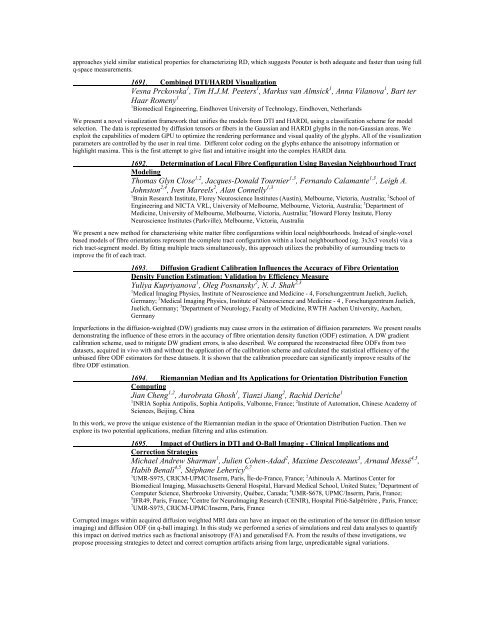Traditional Posters: Diffusion & Perfusion - ismrm
Traditional Posters: Diffusion & Perfusion - ismrm
Traditional Posters: Diffusion & Perfusion - ismrm
Create successful ePaper yourself
Turn your PDF publications into a flip-book with our unique Google optimized e-Paper software.
approaches yield similar statistical properties for characterizing RD, which suggests Poouter is both adequate and faster than using full<br />
q-space measurements.<br />
1691. Combined DTI/HARDI Visualization<br />
Vesna Prckovska 1 , Tim H.J.M. Peeters 1 , Markus van Almsick 1 , Anna Vilanova 1 , Bart ter<br />
Haar Romeny 1<br />
1 Biomedical Engineering, Eindhoven University of Technology, Eindhoven, Netherlands<br />
We present a novel visualization framework that unifies the models from DTI and HARDI, using a classification scheme for model<br />
selection. The data is represented by diffusion tensors or fibers in the Gaussian and HARDI glyphs in the non-Gaussian areas. We<br />
exploit the capabilities of modern GPU to optimize the rendering performance and visual quality of the glyphs. All of the visualization<br />
parameters are controlled by the user in real time. Different color coding on the glyphs enhance the anisotropy information or<br />
highlight maxima. This is the first attempt to give fast and intuitive insight into the complex HARDI data.<br />
1692. Determination of Local Fibre Configuration Using Bayesian Neighbourhood Tract<br />
Modeling<br />
Thomas Glyn Close 1,2 , Jacques-Donald Tournier 1,3 , Fernando Calamante 1,3 , Leigh A.<br />
Johnston 2,4 , Iven Mareels 2 , Alan Connelly 1,3<br />
1 Brain Research Institute, Florey Neuroscience Institutes (Austin), Melbourne, Victoria, Australia; 2 School of<br />
Engineering and NICTA VRL, University of Melbourne, Melbourne, Victoria, Australia; 3 Department of<br />
Medicine, University of Melbourne, Melbourne, Victoria, Australia; 4 Howard Florey Insitute, Florey<br />
Neuroscience Institutes (Parkville), Melbourne, Victoria, Australia<br />
We present a new method for characterising white matter fibre configurations within local neighbourhoods. Instead of single-voxel<br />
based models of fibre orientations represent the complete tract configuration within a local neighbourhood (eg. 3x3x3 voxels) via a<br />
rich tract-segment model. By fitting multiple tracts simultaneously, this approach utilizes the probability of surrounding tracts to<br />
improve the fit of each tract.<br />
1693. <strong>Diffusion</strong> Gradient Calibration Influences the Accuracy of Fibre Orientation<br />
Density Function Estimation: Validation by Efficiency Measure<br />
Yuliya Kupriyanova 1 , Oleg Posnansky 2 , N. J. Shah 2,3<br />
1 Medical Imaging Physics, Institute of Neuroscience and Medicine - 4, Forschungzentrum Juelich, Juelich,<br />
Germany; 2 Medical Imaging Physics, Institute of Neuroscience and Medicine - 4 , Forschungzentrum Juelich,<br />
Juelich, Germany; 3 Department of Neurology, Faculty of Medicine, RWTH Aachen University, Aachen,<br />
Germany<br />
Imperfections in the diffusion-weighted (DW) gradients may cause errors in the estimation of diffusion parameters. We present results<br />
demonstrating the influence of these errors in the accuracy of fibre orientation density function (ODF) estimation. A DW gradient<br />
calibration scheme, used to mitigate DW gradient errors, is also described. We compared the reconstructed fibre ODFs from two<br />
datasets, acquired in vivo with and without the application of the calibration scheme and calculated the statistical efficiency of the<br />
unbiased fibre ODF estimators for these datasets. It is shown that the calibration procedure can significantly improve results of the<br />
fibre ODF estimation.<br />
1694. Riemannian Median and Its Applications for Orientation Distribution Function<br />
Computing<br />
Jian Cheng 1,2 , Aurobrata Ghosh 1 , Tianzi Jiang 2 , Rachid Deriche 1<br />
1 INRIA Sophia Antipolis, Sophia Antipolis, Valbonne, France; 2 Institute of Automation, Chinese Academy of<br />
Sciences, Beijing, China<br />
In this work, we prove the unique existence of the Riemannian median in the space of Orientation Distribution Fuction. Then we<br />
explore its two potential applications, median filtering and atlas estimation.<br />
1695. Impact of Outliers in DTI and Q-Ball Imaging - Clinical Implications and<br />
Correction Strategies<br />
Michael Andrew Sharman 1 , Julien Cohen-Adad 2 , Maxime Descoteaux 3 , Arnaud Messé 4,5 ,<br />
Habib Benali 4,5 , Stéphane Lehericy 6,7<br />
1 UMR-S975, CRICM-UPMC/Inserm, Paris, Île-de-France, France; 2 Athinoula A. Martinos Center for<br />
Biomedical Imaging, Massachusetts General Hospital, Harvard Medical School, United States; 3 Department of<br />
Computer Science, Sherbrooke University, Québec, Canada; 4 UMR-S678, UPMC/Inserm, Paris, France;<br />
5 IFR49, Paris, France; 6 Centre for NeuroImaging Research (CENIR), Hospital Pitié-Salpêtrière , Paris, France;<br />
7 UMR-S975, CRICM-UPMC/Inserm, Paris, France<br />
Corrupted images within acquired diffusion weighted MRI data can have an impact on the estimation of the tensor (in diffusion tensor<br />
imaging) and diffusion ODF (in q-ball imaging). In this study we performed a series of simulations and real data analyses to quantify<br />
this impact on derived metrics such as fractional anisotropy (FA) and generalised FA. From the results of these invetigations, we<br />
propose processing strategies to detect and correct corruption artifacts arising from large, unpredicatable signal variations.















